Hellas Verona are 6th in Serie A and unbeaten in 2020. They conceded just 4 goals in the 8 games they played since the start of the year, a streak that saw them leave San Siro (AC Milan 1–1 Hellas Verona) and the Olimpico (Lazio 0–0 Hellas Verona) undefeated, while handing Juventus their third league loss of the season. An amazing result for a club that was in Serie B last season and spent just €11.2 million in the summer, the third-lowest amount in the Italian top-tier.
One of the main architects of the team's success is certainly the coach, Ivan Jurić. After being fired from Genoa three times in a row, the Croatian coach accepted President Maurizio Setti's offer in the summer, and at the helm of the Gialloblu, he managed to revive a career that seemed already compromised, establishing himself as one of the most brilliant coaches in Serie A.
Jurić was one of the iconic players of Gian Piero Gasperini's Genoa — a team he brought up to Serie A in 2006 and secured a Europa League spot with just three seasons later — and his former coach was a real mentor to him. Although he has gone his own way, his football resembles that of the current Atalanta coach, using man-marking and a three-man defense, as well as instilling a remarkable playing intensity with and without the ball.
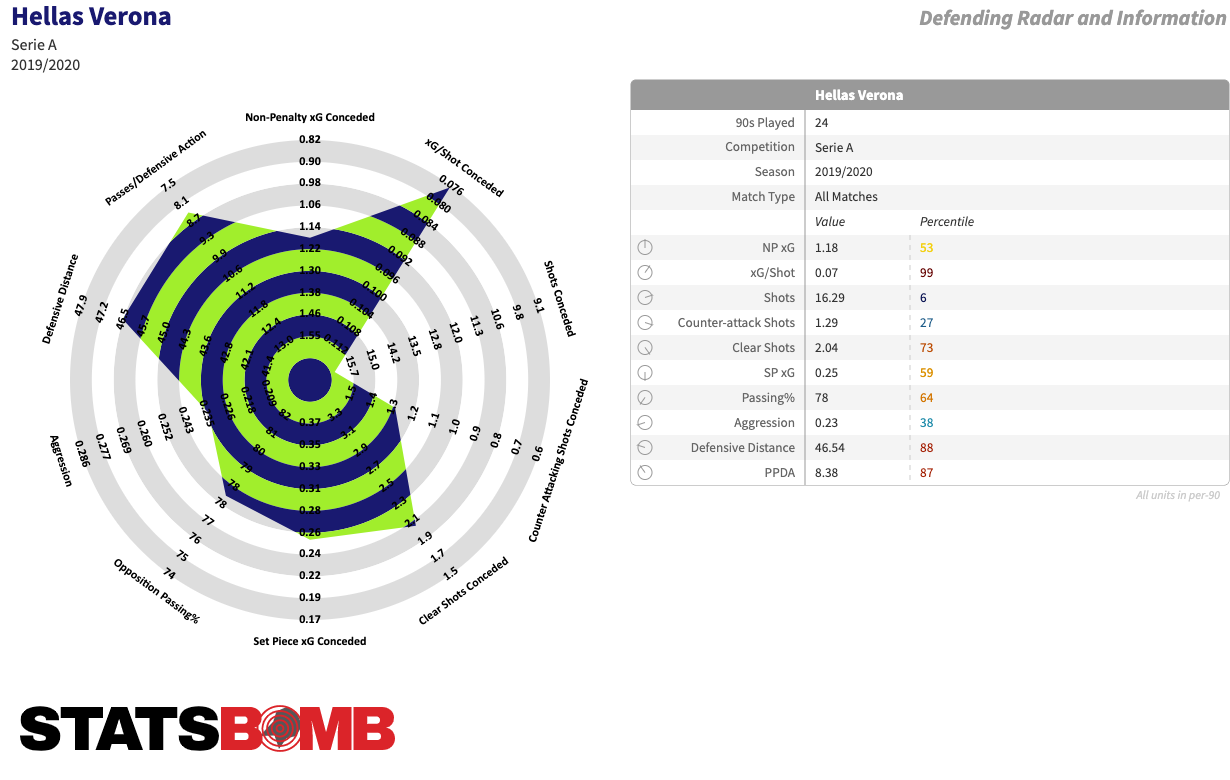
Verona’s passes per defensive action (PPDA) is the 4th best in the league at 8.38 (87th percentile), and they're 4th in the Serie A in opposition passing percentage (78%). They also defend far from their goal (46.54, 5th in the league), at the same average distance as Atalanta (46.60).
Hellas’ favored system of play is the 3-4-2-1: the two attacking midfielders (Mattia Zaccagni, Matteo Pessina or Valerio Verre) occupy the half-spaces and try to hinder the opposing team’s build-up from the first few passes, creating central density with the collaboration of the two holding midfielders, always very aggressive. Midfielders Miguel Veloso (22.13) and Sofyian Amrabat (18.90) average the most pressures for their team. Veloso, whom Jurić coached at Genoa and was thought not very dynamic, has surprised many with his contribution in the defensive phase. He also averages a team-best 4.97 pressure regains (93rd percentile for midfielders in the top 5 leagues).
Their pressing aims to direct the ball to the sidelines, where it's easier to try to recover the ball. Although the wingbacks often push higher up to press, when the opponent's build-up goes wide, the midfielders shift toward the position of the ball. That's a significant distinction compared to Atalanta: in Gasperini’s schemes, the wingbacks are more aggressive and man-oriented. However, the central defenders leaving their position to follow their direct opponents even in the opposing midfield remains common. Marash Kumbulla, Amir Rrahmani, and Koray Günter shine for their intuition, physicality and anticipation.
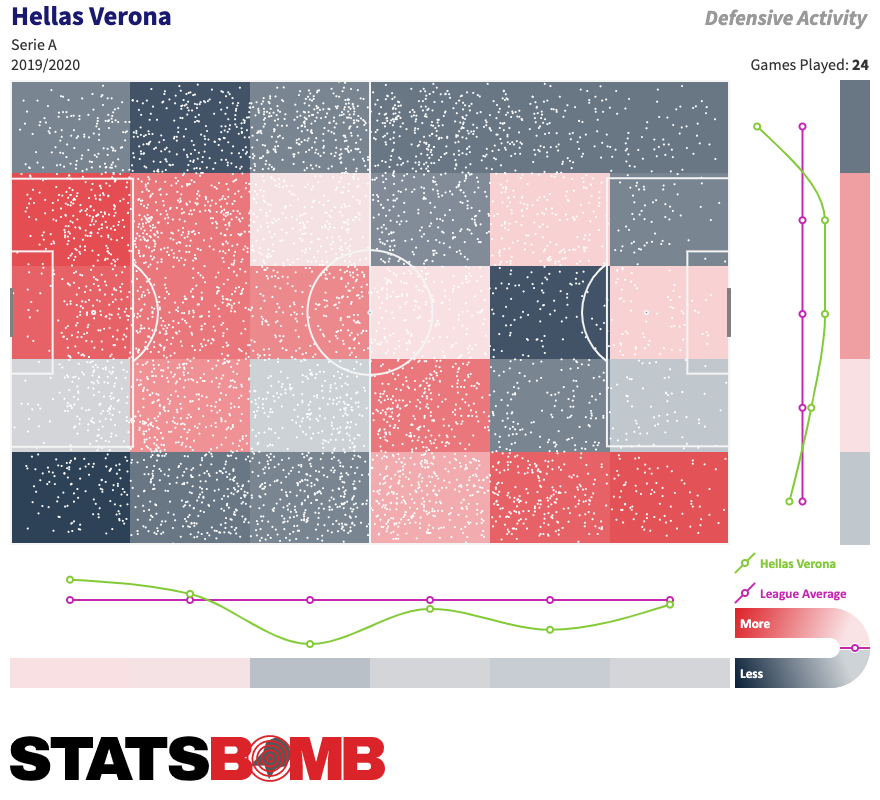
Verona's defense is the fourth-best in the league, so much so that Jurić's team has conceded only one more goal than Juventus (24 against 23). They also share with the Bianconeri the ability to concede low-quality chances: the Gialloblu and the league leader average the lowest value of the league in xG per shot (0.07, 98th percentile in the top 5), a particularly notable achievement for a team that presses so aggressively.
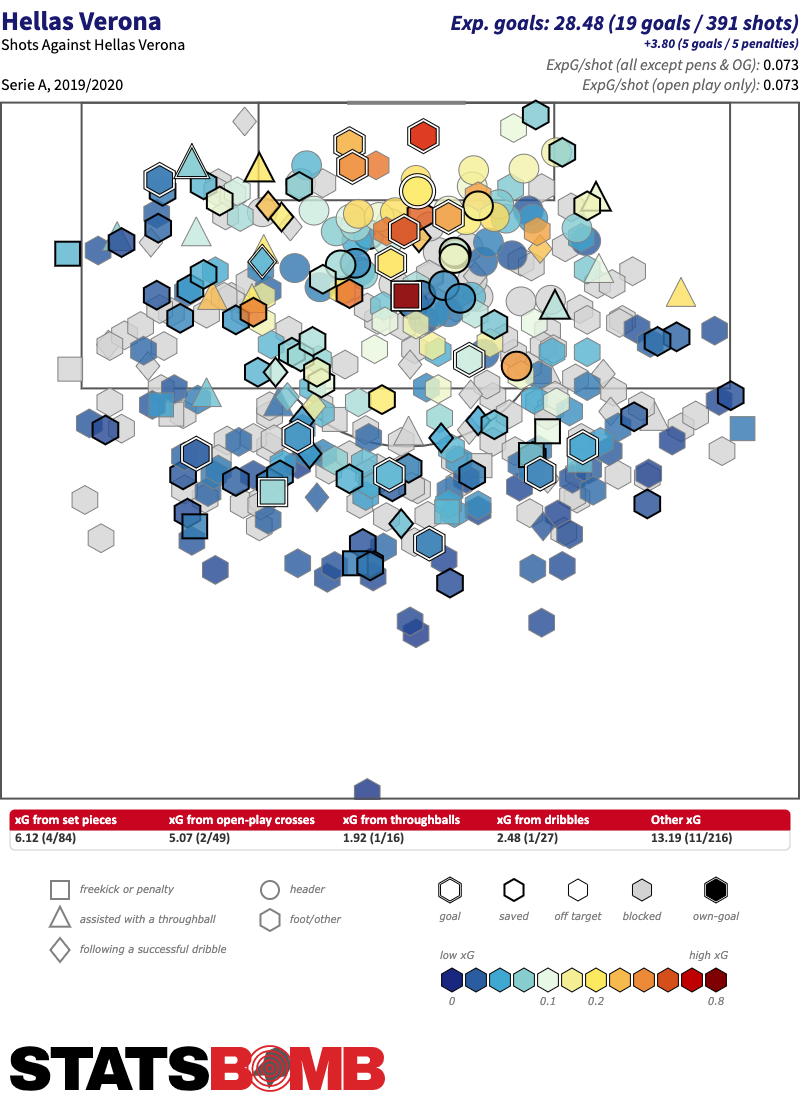
When they can't recover the ball higher up the pitch, Verona are able to regroup in the last 16 meters, maintaining an attitude that is anything but passive and continuing to defend with relative intensity, as shown by their defensive activity map. Despite not being able to suppress the volume of the opponent's shots, they are excellent at avoiding box penetration; their opponents average 6 shots per game from outside the box, just 15.50 dribbles per game (3rd in the league) and a below-average amount of passes inside the box (2.26). All in all, Verona’s defense is formidable. However, it's perhaps also running somewhat hot, conceding around 10 goals less than expected.
Although the defensive phase remains the main asset of the team, their offensive performance has gradually increased and it’s now supporting the team's results as much as their strong defense.
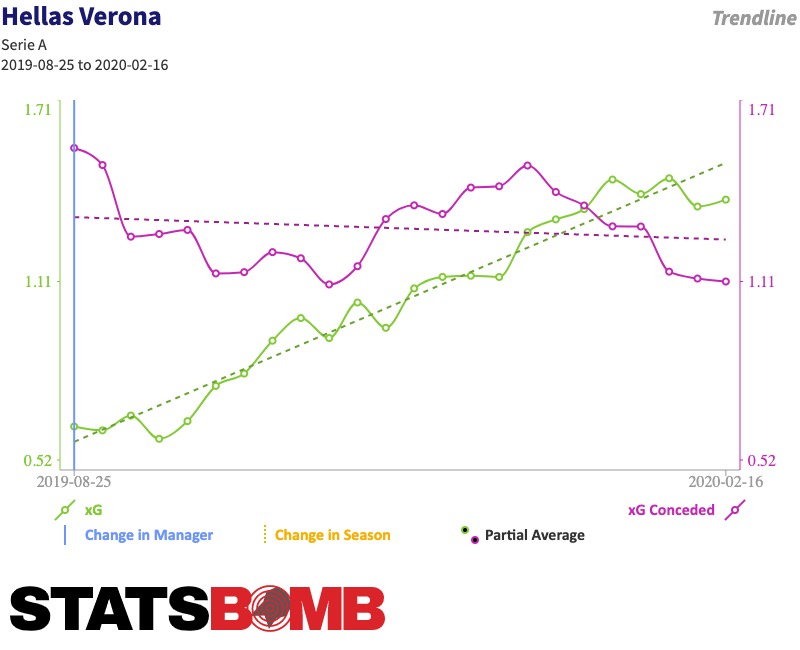
Interestingly, the offensive production improved in the last few games when Jurić decided not to deploy a pure striker, switching to a strikerless system. Verona embraced the motto quality over quantity, to the extent that they are only 18th in shots (11.54) but third in expected goals per shot (0.10). A rather unique feature, especially considering that Verona is a newly promoted team, is the fact that they don’t have a landmark striker. Samuel Di Carmine (756 minutes played) is the only pure forward to feature in the team's xG ranking among players with at least 600 minutes played, with a haul of just 2.41 xG.
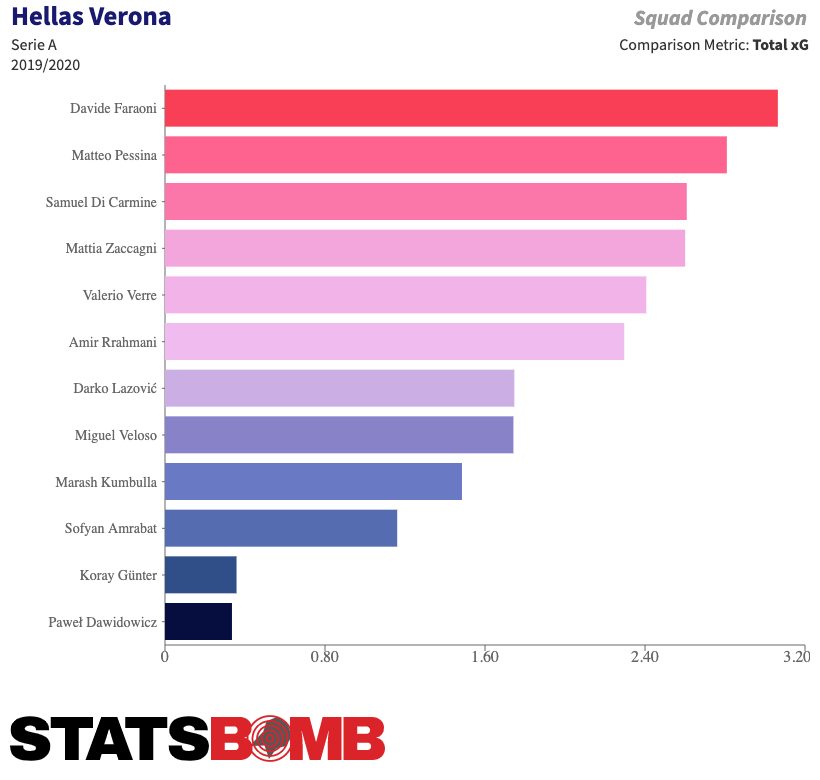
Di Carmine and Valerio Verre are the only players with at least 600 minutes played to average at least 2 shots per 90 minutes. Nevertheless, Verona is also the only team in Serie A that can count on at least 4 players with an average xG/shot of 0.15. Jurić is reminding fans that in modern football the concept of a defined "role" is outdated, often placing midfielder Verre at the center of the attack.
Verona compensate for their lack of a striker by attacking in numbers. When they beat Juventus a week ago, in certain situations the team actually lined up with a 3-2-5. They rely on the rotations and runs of the three offensive players, whoever they are, as well as on the ability of the two wingbacks, Davide Faraoni and Darko Lazović, to create opportunities from the flanks.
Just as there is no primary finisher, ball progression responsibilities are evenly distributed among the central midfielders, offering Verona multiple options to gain territory. For example, Veloso has a vertical and aggressive passing style, while Amrabat prefers to move the ball between zones through dribbles and carries. Verre, Matteo Pessina, Mattia Zaccagni, and Veloso all average roughly 11 final third open-play passes each.
Including penalties, their attack has scored only one more goal (28) than the Serie A current top scorer, Ciro Immobile. Yet despite not being a prolific team, Verona's strength is their ability to not have to rely on one or two key players at an offensive level, but to create opportunities and finalize them with different players. Excluding goalkeepers, 15 players have played at least 350 minutes this season and 13 scored at least one goal. Overall, their performance in front of goal could be better, as suggested by their expected goals. So, while they've been running above expectations on the defensive side, they're actually below expectation in attack, suggesting that, if anything, their goal-scoring is likely to improve over the remainder of the season.
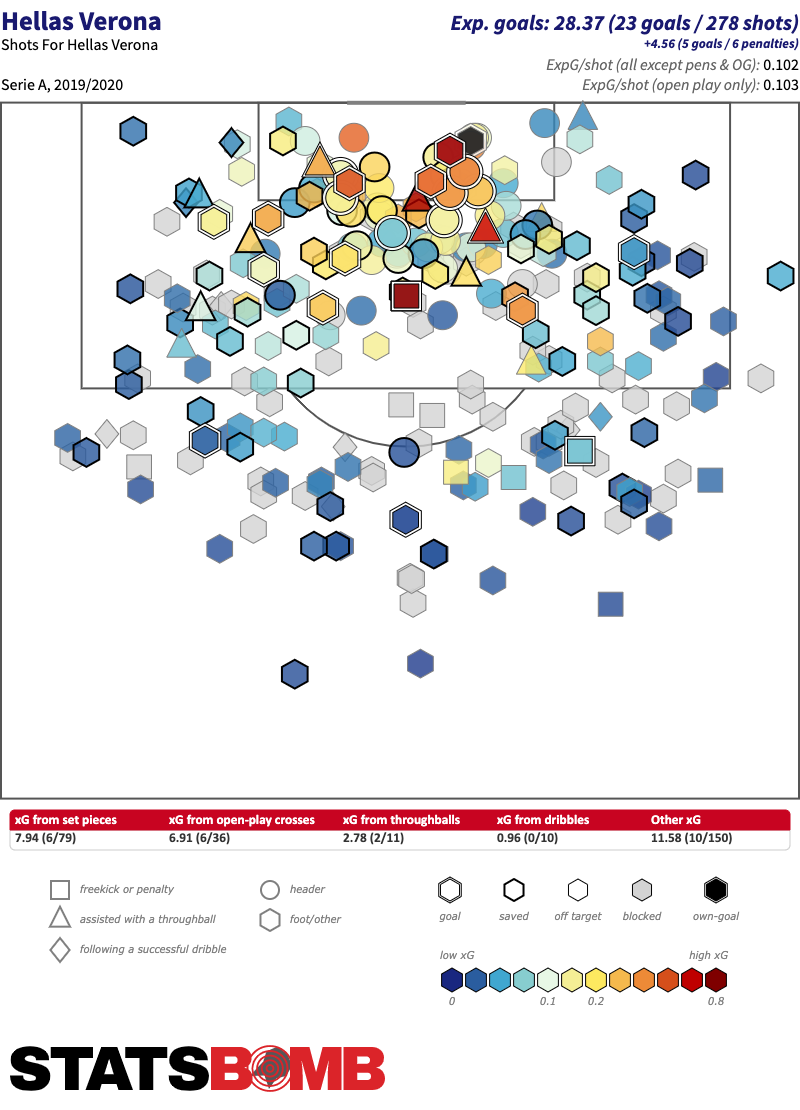
With an average xG difference of just 0.21, Verona is only 11th in Serie A, but their improvement has been steady and consistent. Over the last 9 games, they've finished with a positive xG difference on 7 occasions, while away games at AC Milan and Lazio their xG difference was only slightly negative (-0.51 and -0.10). That's a crucial indicator for their hopes of qualifying for the Europa League, a feat the team will achieve if they remain in sixth.
Looking at future developments for the club, one cannot help but notice the team must give up many key players as early as next summer.
Amrabat, bought in the summer from Club Brugge for just €3.5 million, has already been sold to Fiorentina for around €20 million. The 23-year-old, physically imposing, strong tackling midfielder offers an essential contribution to team pressing. But he is also capable of making himself invaluable in the offensive phase, thanks to his ability to carry the ball and beat his direct opponent to open space in midfield.
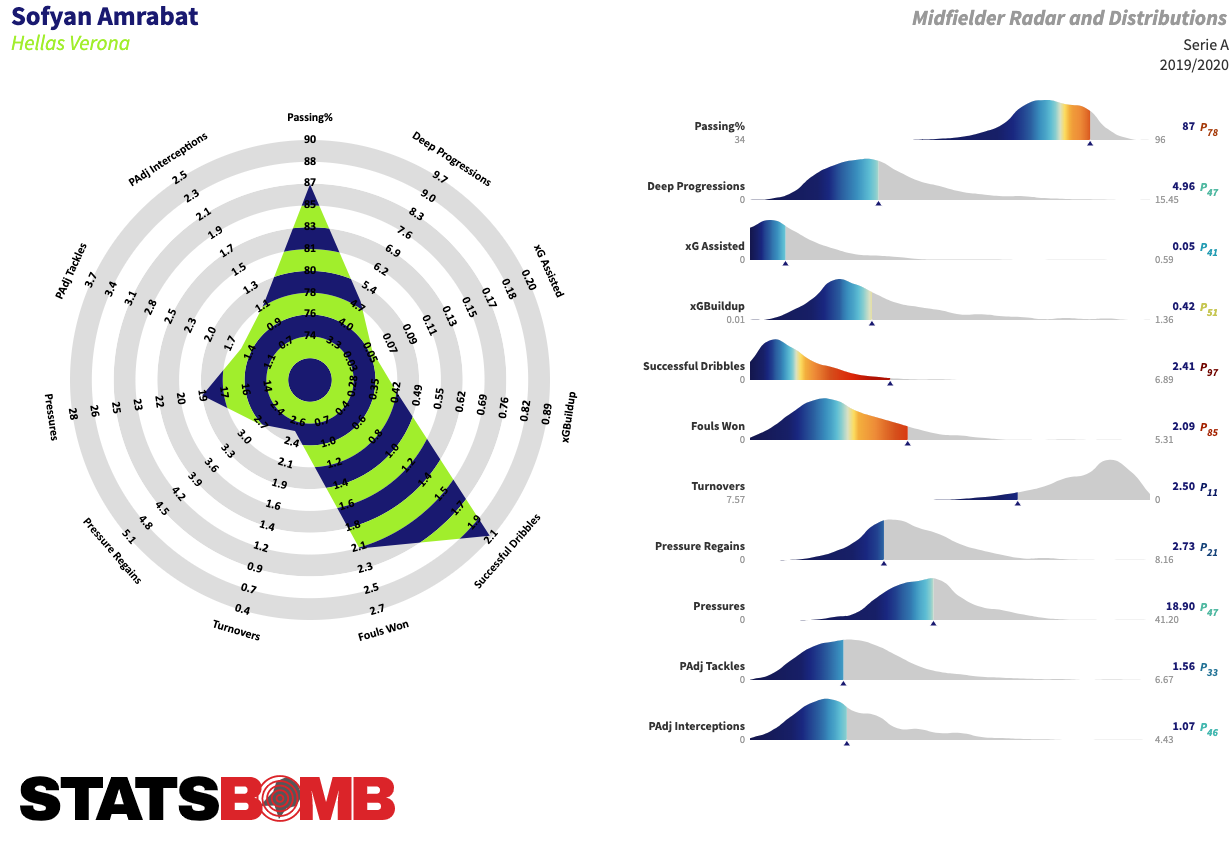
Another important player Verona is already sure to give up is center back Rrahmani: Napoli bought him for €14 million after the Gialloblu purchased him from Dinamo Zagreb for just €2.1 million. He is tall and good at aerial duels, but also very fast, and his decision-making has been really good this season, both on and off the ball. One might even think that Napoli brought him in to replace Kalidou Koulibaly, who despite missing a number of games through injury may be wooed away this summer.
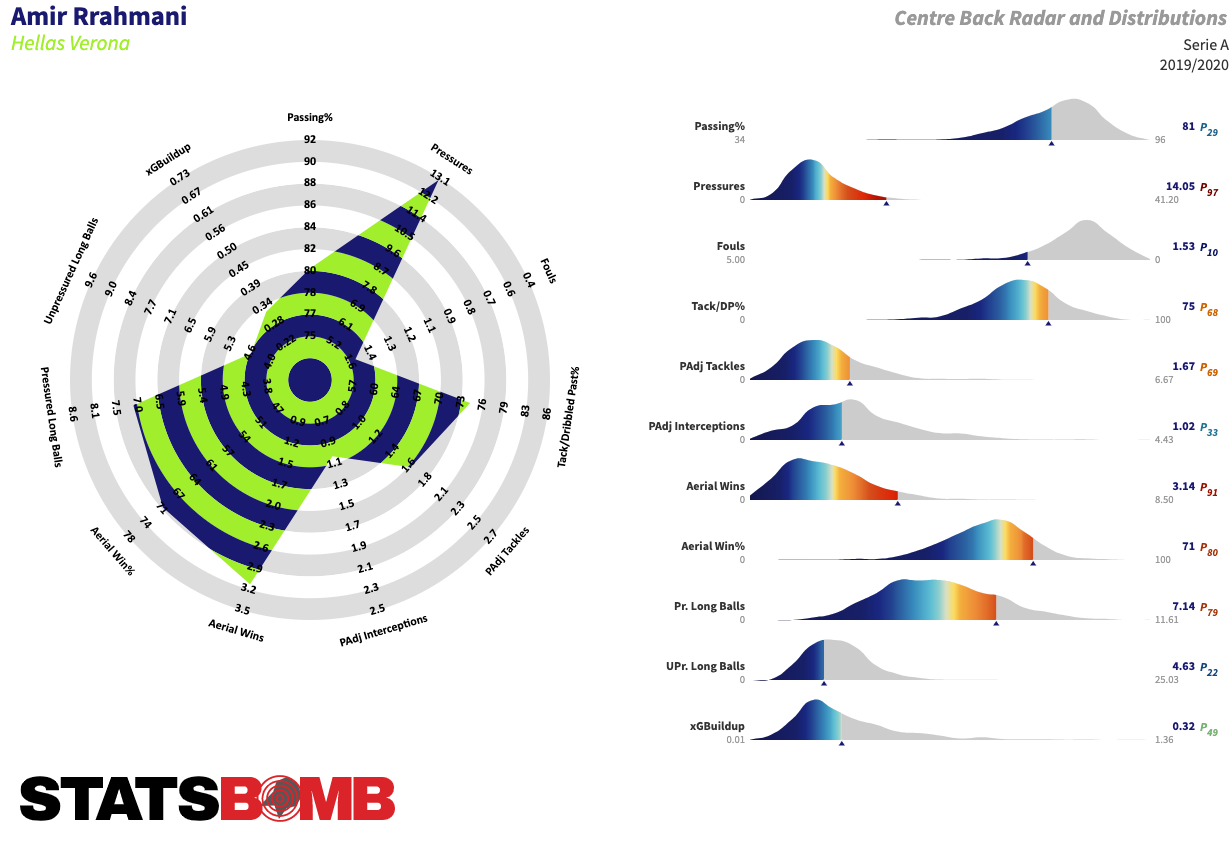
Fellow centre-back Marash Kumbulla, who grew up in the club's academy, is a name already on everyone's lips. At each match, countless scouts from major international clubs watch him from the stands. Just 20, he's very strong physically and is the most aggressive of Verona’s defenders, with a great sense for individual duels that he wins at a 75% clip.
His price tag is already over €20 million and it is likely that these are the last few months playing for the team that developed him. He is not very fast and has yet to show what he can do with the ball at his feet, as his contribution to the build-up is not impressive; however, at his age he has plenty of room for improvement.
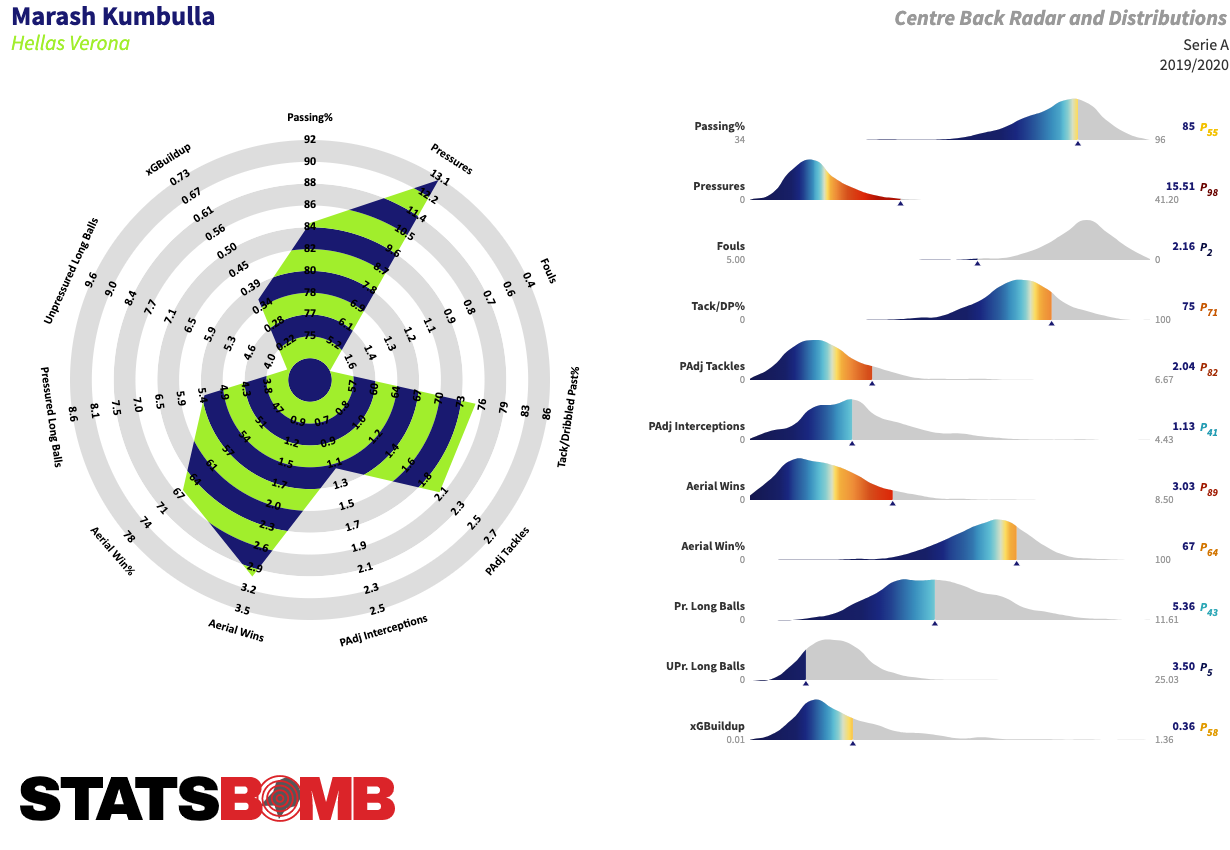
Verona zigged while every other newly promoted team of the last few seasons zagged. Distributing responsibilities among players who have committed to their coach’s ideas, adopting a courageous style of play and applying tactical and strategic concepts that improve efficiency (at a level that might even suggest the use of analytics) should be fundamental principles for any team that wants to survive in the league or to punch above their weight.
Next season's team could be radically different, but this return to the top tier has been a success for the club's finances, too. It is not easy to do overachieve for two seasons in a row, but by maintaining the same principles that have guided this extraordinary season, both on the field and in the transfer market, the club can consolidate their position in the top half of the Serie A standings.